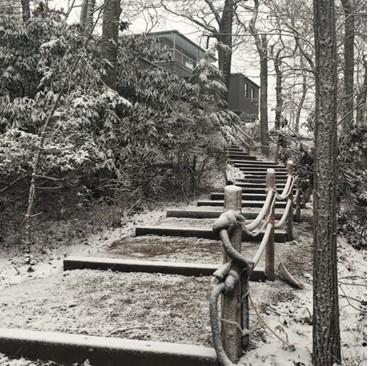The Lloyd Center is Embracing the Snowfall this Winter Season by Adeline Bellesheim, Lloyd Center for the Environment Educator/Naturalist
It’s time to take out those thermals, put on your wool socks, and lace up your boots. The snowy season is here, and it is here to stay! There has been a handful of snow events that have struck the South Coast already, and the staff at the Lloyd Center for the Environment is loving it. The frost-tipped trees and snow-covered trails make for a scene straight out of a fairy tale. A light dusting over our property makes an afternoon stroll to the estuary quite magical.
As educators, naturalists and researchers, we have to approach our lessons and studies a little differently this time of year. The first piece of understanding an ecosystem in the winter is knowing the science behind snow. The formation of snow occurs when the temperature in the atmosphere is at or below 32 degrees Fahrenheit (0 degrees Celsius). The freezing temperatures cause water droplets to freeze on a particle of dust or pollen which in turn leads to the creation of an ice crystal. These ice crystals then begin to absorb the surrounding water vapor, building the six arms of a snow flake through a process of crystallization. This results in the beautiful, symmetrical snowflakes that we know and love.
If you have ever heard that no two snowflakes are exactly alike, it is because each little flake has its own journey to the ground. On their adventure downwards, they encounter unique atmospheric conditions that determine the growth of the crystals. Slight changes in pressure, humidity, and temperature all impact the final shape of the flakes. These minor differences may not be visible to the naked eye, but each prism, needle, and lace shape, maintains its own identity.
Snow is in a continuous state of change from the time it forms until the time that it melts and evaporates to re-join the water cycle. Once a snowflake has reached its destination at ground level, it is still subject to wind that will move or break the flakes, fluctuations through melting and evaporation, and subsequent snow that can compact and compress it. In regions of the world with a record of heavy snowfall, scientists are able to learn a lot from the layers of snow that have accumulated over many, many years. The stratifications from numerous snowfalls can help us understand historical climate and weather patterns in that area.
It is easy to focus our minds on the challenges that winter weather events bring our way. Between frozen windshields and slippery stairs, frustrations can run high after a heavy snowfall. As children we enjoy snowball fights and snow slushies, but as adults we worry about dangerous commutes and falling on ice. Take some time this winter to appreciate the beauty and science that comes with each individual flake that falls your way. Enjoy the brightly colored winterberries popping through the snow-white backdrop. Pause for a few minutes and look out for the red head of a red-bellied woodpecker or the brilliant blue feathers of a blue jay. No matter what we do, the snow will come this time of year, so if you can’t escape it, you might as well enjoy it!













